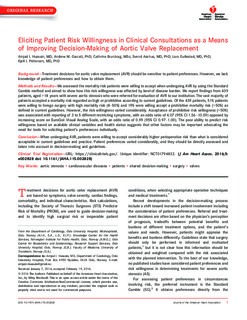| dc.contributor.author | Hussain, Amjad | |
| dc.contributor.author | Garratt, Andrew | |
| dc.contributor.author | Brunborg, Cathrine | |
| dc.contributor.author | Aakhus, Svend | |
| dc.contributor.author | Gullestad, Lars | |
| dc.contributor.author | Pettersen, Kjell I | |
| dc.date.accessioned | 2016-11-21T16:17:18Z | |
| dc.date.accessioned | 2016-11-24T14:31:11Z | |
| dc.date.available | 2016-11-21T16:17:18Z | |
| dc.date.available | 2016-11-24T14:31:11Z | |
| dc.date.issued | 2016 | |
| dc.identifier.citation | Journal of the American Heart Association 2016, 5(3) | nb_NO |
| dc.identifier.issn | 2047-9980 | |
| dc.identifier.uri | http://hdl.handle.net/11250/2422940 | |
| dc.description.abstract | Background: Treatment decisions for aortic valve replacement (AVR) should be sensitive to patient preferences. However, we lack knowledge of patient preferences and how to obtain them.
Methods and Results: We assessed the mortality risk patients were willing to accept when undergoing AVR by using the Standard Gamble method and aimed to show how this risk willingness was affected by level of disease burden. We report findings from 439 patients, aged >18 years with severe aortic stenosis who were referred for evaluation of AVR to our institution. The vast majority of patients accepted a mortality risk regarded as high or prohibitive according to current guidelines. Of the 439 patients, 51% patients were willing to forego surgery with high mortality risk (8–50%) and 19% were willing accept a prohibitive mortality risk (>50%) as defined in current guidelines. However, the risk willingness varied considerably. Acceptance of prohibitive risk willingness (>50%) was associated with reporting of 3 to 5 different restricting symptoms, with an odds ratio of 4.07 (95% CI 1.56–10.59) opposed by increasing score on EuroQol–Visual Analog Scale, with an odds ratio of 0.99 (95% CI 0.97–1.00). The poor ability to predict risk willingness based on available clinical variables and health status suggests that other factors may be important advocating the need for tools for soliciting patient's preferences individually.
Conclusion: When undergoing AVR, patients were willing to accept considerably higher perioperative risk than what is considered acceptable in current guidelines and practice. Patient preferences varied considerably, and they should be directly assessed and taken into account in decision‐making and guidelines. | nb_NO |
| dc.language.iso | eng | nb_NO |
| dc.publisher | American Heart Association | nb_NO |
| dc.relation.uri | https://www.ncbi.nlm.nih.gov/pmc/articles/PMC4943260/ | |
| dc.rights | Navngivelse-Ikkekommersiell 3.0 Norge | * |
| dc.rights.uri | http://creativecommons.org/licenses/by-nc/3.0/no/ | * |
| dc.title | Eliciting Patient Risk Willingness in Clinical Consultations as a Means of Improving Decision-Making of Aortic Valve Replacement | nb_NO |
| dc.type | Journal article | nb_NO |
| dc.type | Peer reviewed | nb_NO |
| dc.date.updated | 2016-11-21T16:17:17Z | |
| dc.source.volume | 5 | nb_NO |
| dc.source.journal | Journal of the American Heart Association | nb_NO |
| dc.source.issue | 3 | nb_NO |
| dc.identifier.doi | 10.1161/JAHA.115.002828 | |
| dc.identifier.cristin | 1402562 | |
| dc.description.localcode | (c) 2016 The Authors. Published on behalf of the American Heart Association, Inc., by Wiley Blackwell. This is an open access article under the terms of the Creative Commons Attribution-NonCommercial License, which permits use, distribution and reproduction in any medium, provided the original work is properly cited and is not used for commercial purposes. | nb_NO |

